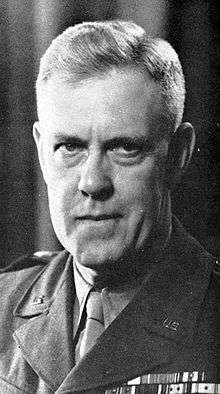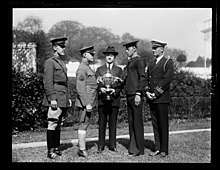Paul W. Baade
Paul William Baade (April 16, 1889 – October 9, 1959) was a highly decorated United States Army officer, with the rank of Major General. The United States Military Academy alumni and veteran of World War I, he is most noted as a Commander of 35th Infantry Division during World War II.[1]
Paul William Baade | |
|---|---|
 | |
| Born | April 16, 1889 Fort Wayne, Indiana |
| Died | October 9, 1959 (aged 70) San Francisco, California |
| Allegiance | |
| Service/ | |
| Years of service | 1911–1946 |
| Rank | |
| Service number | 0-3099 |
| Unit | |
| Commands held | |
| Battles/wars | World War I
|
| Awards | Distinguished Service Medal Silver Star (2) Legion of Merit Bronze Star Medal (3) |
Baade distinguished himself during his service in the Battle of Normandy, where he received several decorations for bravery and leadership. He later led his division during the Siege of Bastogne and combats in the Netherlands.[2][3][4][5]
Early years
Paul William Baade was born on April 16, 1889 in Fort Wayne, Indiana as a son of Fred C. Baade and his wife Anna Paul. Following the high school, he received an appointment to the United States Military Academy at West Point, New York in June 1907 and earned nickname "Baby Paul" due to his clear blue eyes and velvet-like skin. During his time at the Academy, Baade reached the rank of Cadet lieutenant and was active in baseball and hockey squads.[3][4][5][6]
He graduated on June 13, 1911 with Bachelor of Science degree and was commissioned a Second lieutenant in the Infantry on the same date. Many of his classmates became a general officer during World War II. For example: Charles P. Hall, William H. H. Morris Jr., Raymond A. Wheeler, John P. Lucas, Herbert Dargue, Ira T. Wyche, Frederick Gilbreath, Gustav H. Franke, Philip B. Fleming, Thompson Lawrence, Joseph C. Mehaffey, Harold F. Nichols and James R. Weaver.[6]
Upon the commissioning, Baade was attached to the 11th Infantry Regiment at Fort D.A. Russell, Wyoming and remained there until February 1913. During his service at Fort D.A. Russell, he married his longtime sweetheart, Margaret Craig, in June, 1912.[3][4][1]
He subsequently served with 11th Infantry at Mexican Border at Texas City, Texas until he embarked to the Philippines for service with 8th Infantry Regiment. While in the Philippines, he reached the rank of Captain and returned to the United States in mid-1916 for duty with 54th Infantry Regiment at Chickamaugua Park in Georgia.[3][4][7]
World War I

Following the United States' entry into World War I in April 1917, Baade was promoted to the temporary rank of Major and attended the Sixth Division’s Foreign Officers’ School. He then served at Camp Wadsworth, South Carolina until he embarked for France with the advance party of the 81st Infantry Division under Brigadier general Charles H. Barth in July 1918.[3][1]
Baade was promoted to the temporary rank of lieutenant colonel and attached to the 322nd Infantry Regiment. He commanded battalion during the occupancy of the Saint-Dié Sector and later took part in the bitter actions east of the Soin-Medieu Sector and in the Argonne Forest.[3][4]
Upon the Armistice was signed, he was stationed at Laignes until June 1919, when his regiment was ordered back to the United States and demobilized at Camp Lee, Virginia. Baade was reverted to his peacetime rank of Captain.[3][4][7]
Interwar period
Baade was then appointed Professor of Military Science & Tactics at Boston University and remained in this capacity until summer 1923, when he entered the course at Command and General Staff College at Fort Leavenworth, Kansas. Following the graduation one year later, he served in the Office of the Chief of Infantry under Major general Charles S. Farnsworth until he was sent to the Junior course at the Army War College in Washington, D.C. in June 1928. During his service in Washington, Baade also served as Army Athletic Officer during the 1924 Army and Navy in a football contest.[3][5]
He was promoted to the permanent rank of Major in July 1927 shortly after his graduation from Army War College and assume duty with 29th Infantry Regiment at Fort Benning, Georgia. Baade served as regimental Plans & Training Officer until August 1935, when he was transferred to the staff of Sixth Corps Area as Assistant Chief of Staff for logistics under Major general Frank Ross McCoy. He was promoted to lieutenant colonel on August 1, 1935.[8][3]
Baade assumed duty as Acting Chief of Construction Division, War Department General Staff in September 1936 and served in this capacity, until he assumed duty as Chief of Construction Division in June 1938. He was transferred to Fort Jay, New York in August 1939 and served as Executive Officer, 16th Infantry Regiment until June 1940, when assumed command of the regiment. Baade was promoted to Colonel at the time.[8][3][4]
He served with the regiment during the Georgia and Louisiana maneuvers and following an appointment as Commanding officer, Baade led his unit during the maneuvers in northern New York. He was then stationed with the regiment at Fort Devens until he was promoted to the temporary rank of Brigadier general and appointed Commanding general, Puerto Rico General Department in July 1940. His headquarters was located at Fort Buchanan and he also commanded the General Depot, and the Mobile Force there.[8][3][4][5][1]
World War II
Stateside service
In July 1942, Baade was ordered to Camp San Luis Obispo, California and attached to 35th Infantry Division under Major General Maxwell Murray as Assistant Division Commander. Baade succeeded general Murray in January 1943 and received promotion to Major general one month later. He led his division during the Tennessee Maneuvers between November 1943 and January 1944 and during the mountain warfare training in West Virginia Maneuver Area.[8][3][4]
European Theater
Baade embarked for England with 35th Division in May 1944 and after few weeks there, it was ordered for France. He landed in Normandy on July 5, 1944 and entered combat seven days later at the outskirts of Saint-Lô. The 35th Division repelled twelve German counterattacks at Emelie before entering Saint-Lô on July 18. After mopping up in the Saint-Lô area, it took part in the offensive action southwest of Saint-Lô, pushing the Germans across the Vire River on August 2, and breaking out of the Cotentin Peninsula. Baade was later decorated with Silver Star for his early service in Normandy.[2][4]
Between August 7 to 13, 1944, Baade led 35th Division during the assault at Mortain and repelled a strong enemy counter-offensive. He subsequently took part in the rescue of the 30th Division's "Lost Battalion" which had been surrounded. Baade constantly visited his front line troops, inspiring and encouraging them by his courageous personal example. Under his gallant leadership the Division accomplished its mission and relieved the besieged battalion. Baade was subsequently decorated with second Silver Star.[2][3][4]
Baade commanded his division during the Battle of Nancy in mid-September and helped secure the city after a week of bitter fighting. The 35th Division then secured Chambrey on October 1, and drove on to the German border, taking Sarreguemines and crossing the Saar on December 8. After crossing the Blies River on December 12, the division moved to Metz for rest and rehabilitation on December 19. For this period of service, Baade received Army Distinguished Service Medal and Legion of Honor, rank Officer and Croix de guerre 1939-1945 with Palm by the Government of France.[2][3][4][1]
The Division's rest was interrupted by the massive German counterattack in mid-December 1944 and Baade took part in the fighting to relieve Bastogne, throwing off the attacks of four German divisions, taking Villers-laBonne-Eau on January 10, after a 13-day fight and Lutrebois in a 5-day engagement. On January 18, 1945, the division returned to Metz to resume its interrupted rest.
Baade and his division was defending the Foret de Domaniale area at the end of January 1945 and then moved to the Netherlands to hold a defensive line along the Roer on February 22. The division subsequently attacked across the Roer, pierced the Siegfried Line, reached the Rhine at Wesel on March 10, and crossed March 25–26. It destroyed the enemy's defenses across the Herne Canal and reached the Ruhr River early in April, when it was ordered to move to the Elbe April 12.[3]
The 35th Division finished his World War II service in Hanover, where it took part in the mopping-up duty until VE-day. For his service in 1945, Baade received Legion of Merit, three Bronze Star Medals and Dutch Order of Orange-Nassau, rank Grand Officer.[2][4][5][1]
Post World War II
Baade subsequently commanded his division during the occupation of Hanover and Recklinghausen, and then governed the Coblenz area until late July 1945, when the control was relinquished to the French Army. The 35th Division was subsequently ordered for England and then embarked for the United States, where it was inactivated at Camp Breckinridge, Kentucky on December 7, 1945.[3][4]
He was subsequently appointed Assistant Chief of Staff for Operations (G-3), Army Service Forces under General Brehon B. Somervell. Following the deactivation of Army Service Forces on June 11, 1946, Baade was ordered home, awaiting retirement. He retired from active duty on September 30, 1946 after 35 years of commissioned service.[8]
On December 7, 1946 Baade and his wife survived the Winecoff Hotel fire in Atlanta, Georgia by crawling across a plank to a neighboring building.[9]
Baade resided in Santa Barbara, California and served as Vice president of the Botanic Gardens and also on the boards of directors of the Channel City Club, of the Valley Club of Montecito, and of the Montecito Board. He was also active in the Episcopal Church.[3]
Major general Paul W. Baade died on October 9, 1959 in San Francisco, California and was buried with full military honors at Arlington National Cemetery, Virginia beside his wife Margaret Craig Baade (1891-1977) and their only daughter, Margaret Anne Baade (1916-1928), who died following a Mastoiditis surgery.[10][11][7][1]
Decorations
Here is Major general Baade´s ribbon bar:[2]
| 1st Row | Army Distinguished Service Medal | Silver Star with Oak Leaf Cluster | ||||||||||||||
|---|---|---|---|---|---|---|---|---|---|---|---|---|---|---|---|---|
| 2nd Row | Legion of Merit | Bronze Star Medal with two Oak Leaf Clusters | Purple Heart | World War I Victory Medal with two Battle Clasps | ||||||||||||
| 3rd Row | American Defense Service Medal with Foreign Service Clasp | American Campaign Medal | European-African-Middle Eastern Campaign Medal with four 3/16 inch service stars | World War II Victory Medal | ||||||||||||
| 4th Row | Army of Occupation Medal | Officer of the Legion of Honor (France) | French Croix de guerre 1939-1945 with Palm | Grand Officer of the Dutch Order of Orange-Nassau | ||||||||||||
See also
| Military offices | ||
|---|---|---|
| Preceded by Major General Maxwell Murray |
Commanding General, 35th Infantry Division January 1943 – December 1945 |
Succeeded by deactivated |
References
- "Major general Paul W. Baade Papers - 35th Infantry Division Association".
- "Valor awards for Paul W. Baade". valor.militarytimes.com. Militarytimes Websites. Retrieved 12 April 2017.
- "Paul W. Baade 1911 - West Point Association of Graduates".
- "Paul W. Baade - World War II Unit histories & Officers".
- "Paul William Baade - Arlington National Cemetery".
- "The Howitzer 1911 – Yearbook of United States Military Academy".
- "Paul W. Baade Papers - Truman Library".
- "Biography of Major-General Paul William Baade (1889 - 1959), USA". generals.dk. generals.dk Websites. Retrieved 12 April 2017.
- Darkest Hours, Jay Robert Nash, New York: Pocket Books, 1977, p. 618
- "MG Paul William Baade (1889 – 1959) – Find A Grave Memorial".
- "Margaret Anne Baade (1916-1928) – Find A Grave Memorial".